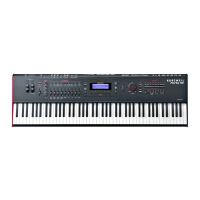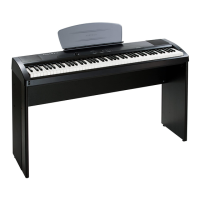Program Edit Mode
Editing KB3 Programs
3-106
Drawbars
One of the standard performance features of many tone wheel organs is the set of drawbars
for emulating the stops on a pipe organ. Moving the drawbars controls the amplitude of
either the fundamentals or the harmonics of the notes. e PC4’s sliders serve as the nine
drawbars found on most tone wheel organs. Pushing the sliders up is the equivalent of
pushing the drawbars in (removing fundamentals or harmonics).
Buttons
When using a KB3 program, the buttons below the sliders control KB3 eects. Each button
is labeled with a KB3 function, and their LEDs indicate the status of each eect.
Use the Variation button to toggle the Rotary speed between slow or fast.
Chorus and Vibrato each have 3 levels of depth. Depth 1 has the least amount of eect
applied, Depth 3 has the most. Pressing the Chorus/Vibrato Depth button toggles between
Depth 1 (LED o) and Depth 3 (LED on). You can also set the depth on the KB3
Parameters page using the Chorus/Vibrato Depth parameter. Values 0-42 = Depth 1, 43-85
= Depth 2, 86-127 = Depth 3.
Additional KB3 Controller Assignments
Other default assignments for factory KB3 programs include:
CC Pedal 1 (volume) controls preamp volume, which emulates the volume control of an
organ preamp. e PreampResp parameter must be set to On for this to work (the default
setting). See PreampResp on page 3-108 for details.
Mod Wheel controls Distortion Drive.
Switch Pedal 1 (sustain) controls the rotary speaker eect, which toggles the Rotary speed
between slow or fast. is has the same eect as using Rotary S/F (Variation button).
KB3 Programming Tips
e following section provides some starting points for creating your own KB3 programs.
e most prominent dierence between organ vintages is the number of tone wheels used.
Keep in mind, however, that the sound of an actual tone wheel organ will depend not only
on its age, but also on how well it has been maintained.
Early Tone Wheel Organs. Instruments of this period had 91 tone wheels. To get this sound,
go to the TONEWL page, select 91 tone wheels, and set lowest pitch to C 1. Start with the
Junky Wheel Volume Map and Bob’s Organ Map. You may also want to increase the Key
Click level, since this tends to become louder on older organs.
Middle Period Organs. To model one of these instruments, set 82 tone wheels and a low
note of A 1. Use the Mellow Wheel Volume Map and Eric’s Organ Map. Set Key Click to a
moderate level.

